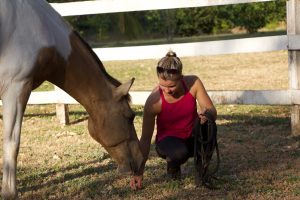There is something that top competitors in every sport understand that can be applied at any level of riding to help us and our horses.
I heard this explained at a clinic with my friend, and amazing horsewoman, Barbra Shulte. Barbra is a professional cutting horse trainer, the first woman to win all three prestigious championships in cutting.
Barbra also studies and coaches personal performance, so she knows what really goes into peak performance.
Just to clarify something here… I believe that peak performance is not just for competitions and athletes. Many of the same principles and practices that create great “performance” also mean connection to yourself, to your horse, and being fully immersed in what you are doing – even if that is simply a Tuesday afternoon schooling ride.
During this clinic I attended, Barbra mentioned the concept of “recovery time” and how, in any activity, there is a rhythm between going full out, full focus, and then moments of relaxation to allow for being fully on again.
Now “relaxation” doesn’t necessarily mean stopping and hanging out. There are levels of recovery.
I explain more in the video below.
See you in the comments,
Callie














14 Responses
I could definitely use recovery after doing circles. Bending can be difficult for my horse and so my focus is pretty intense as I use my aids to help him complete the circle. It would be good to take the mini break right after that.
That is a great example of how to take a break and find sometime to rest – I think you’ll notice the bending gets even better 🙂
-Julia, HorseClass Community Manager
Great info Callie, thanks so much.
Glad you enjoyed this post Lary!
-Julia, HorseClass Community Manager
I could use this in my transitions, during my half or full circle around around the arena when I finish one thing I’m working on and getting ready to move into the next. Or even during the work when I find a comfortable place to practice it.
Absolutely Jennifer, that is a great idea!
-Julia, HorseClass Community Manager
Great video n the importance of those resting moments. I saw it today when my coach was riding my gelding. She would work his walk/ canter transition, and when he did it well, she stopped him, praised him and dropped the reins. An immediate message that he did good. Giving him time to process what it was he just did that earned him the praise. So he can put it into his memory banks.
This goes for all the times I’ve learned to seek something with either of my horses and then pause when they were completed until they licked and chewed. Giving them (and myself) the valuable moment to process versus simply repeating over and over. I find this way, we only repeat it 2-4 times and move onto something else. They’ve got it.
For myself, I’ve been focusing on my breath this past two weeks specifically. What a difference that has done for ease of transitions (up and down), connection, having the horse lift up under me more, feeling my body awareness more. All of which supports my improvement in performance. I’ve witnessed deep yawns from my horses after sections of me focusing on my breath. Profound
Great game plan Pauline! Giving both ourselves and our horses time to process is key win the learning process 🙂
Isn’t it amazing what just focusing on your breath can change?
-Julia, HorseClass Community Manager
My mare and I take breaks by walking on the buckle for a few minutes. My goal is to get her to relax with a little contact, the mini breaks.
I was going to say exactly the same. I ride a school horse but she has been designated “my horse” for some time now. My instructor encourages connections with the horses we ride outside the scope of performance. I call it our playtime. Sometimes I will also drop my stirrups and just let the mare I ride take the lead and simply go with her flow. Other times I will take her to the center of the arena and simply stop and give her a good scratch to her withers. We also try to end each arena lesson with a short trail ride. On long trail rides I go back and forth between riding with intention and relaxation. We simply amble along and I match my breathing to hers.
Great way to take a break when you are teaching connection in the bridle Dorothy!
-Julia, HorseClass Community Manager
I like the idea of training a break every 15 minutes or so, especially if I’ve really been working his brain quite a bit. He responds well if we go into the center of the ring for a deep breath. We break after direction changes
Breaks are so important – sounds like you have a great training plan in place 🙂
-Julia, HorseClass Community Manager
I ride a school horse who is 24 years old. I feel like I rarely have a break time unless I totally stop. I have to constantly be working at keeping him moving forward or preventing him from transitioning down, from a trot to a walk, for example.
I see the benefit of learning to feel when he is going to “break.” But sometimes it seems like I’m working harder than he is; I’m doing more of the work.